
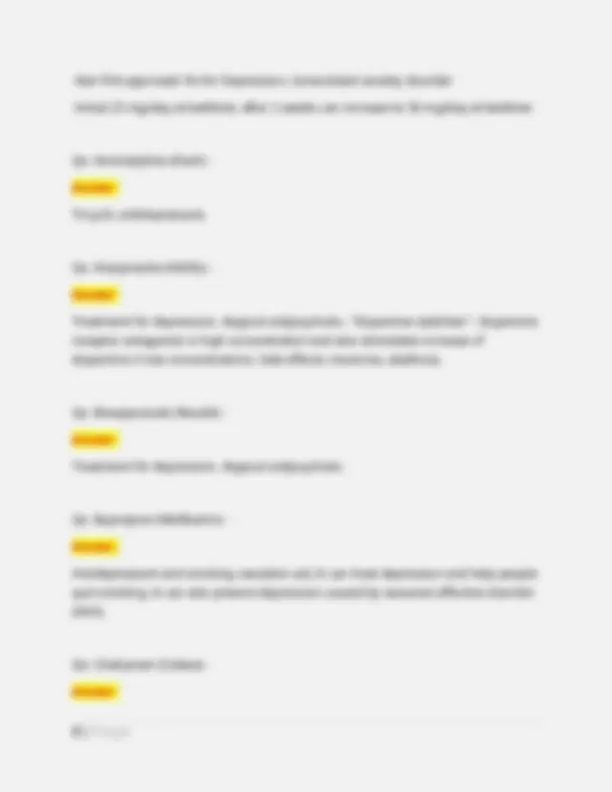
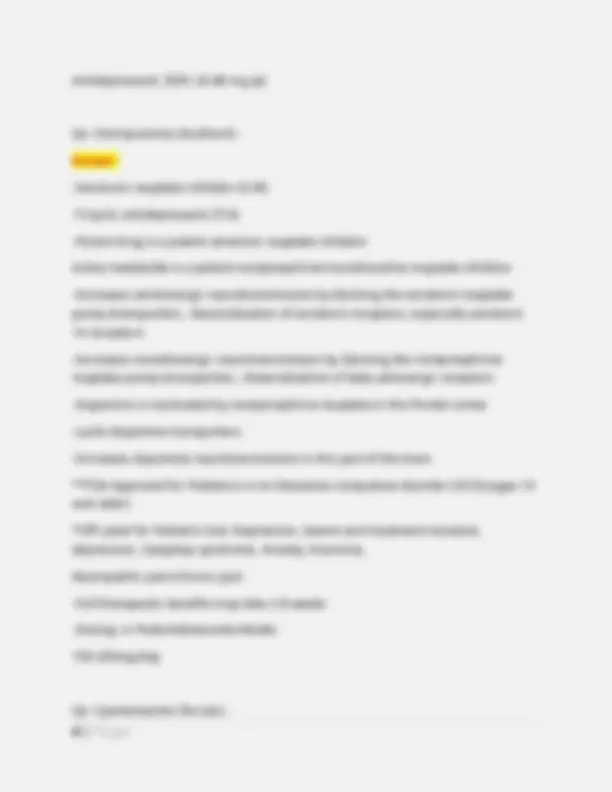
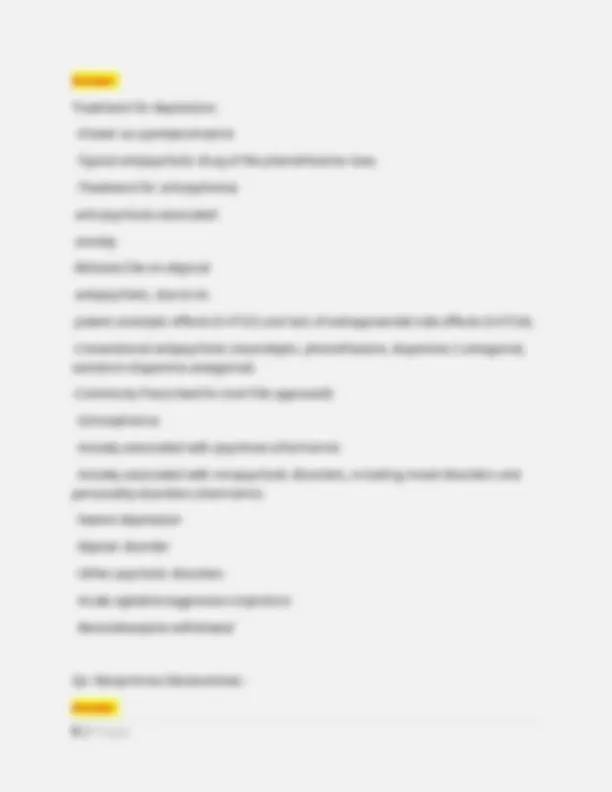
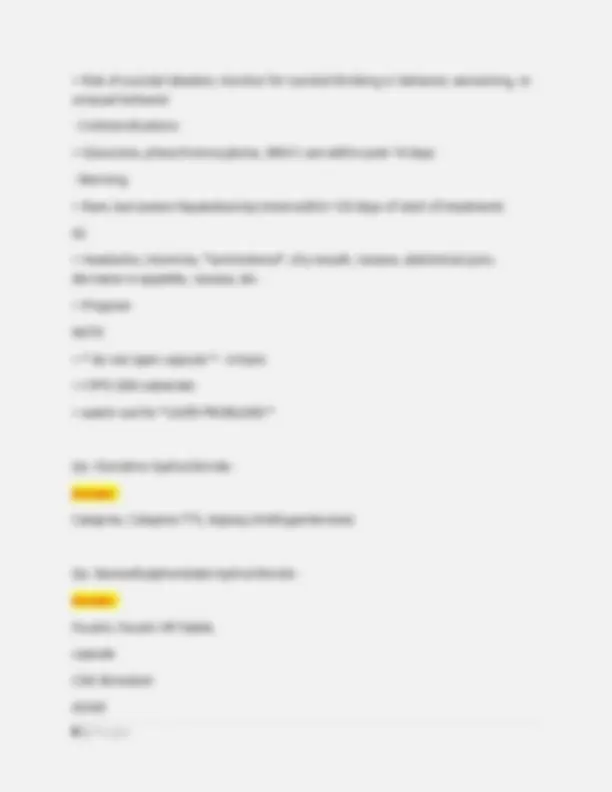
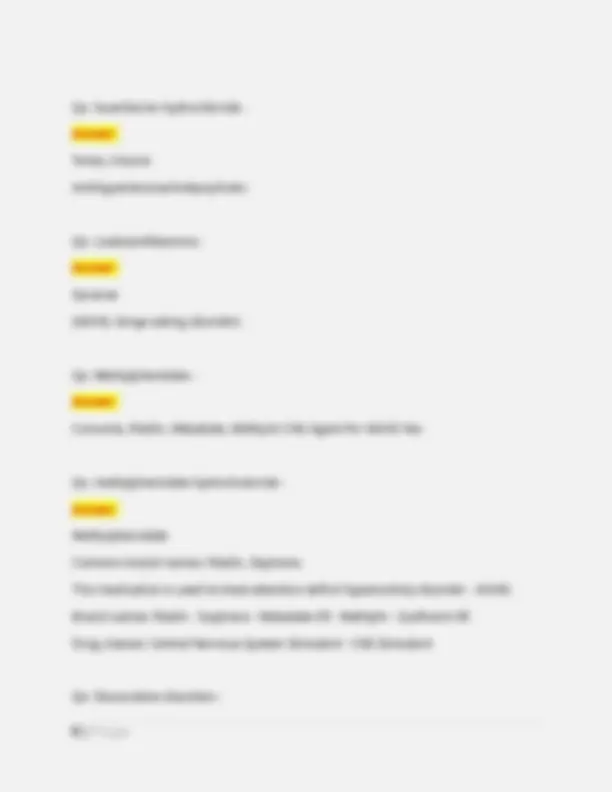
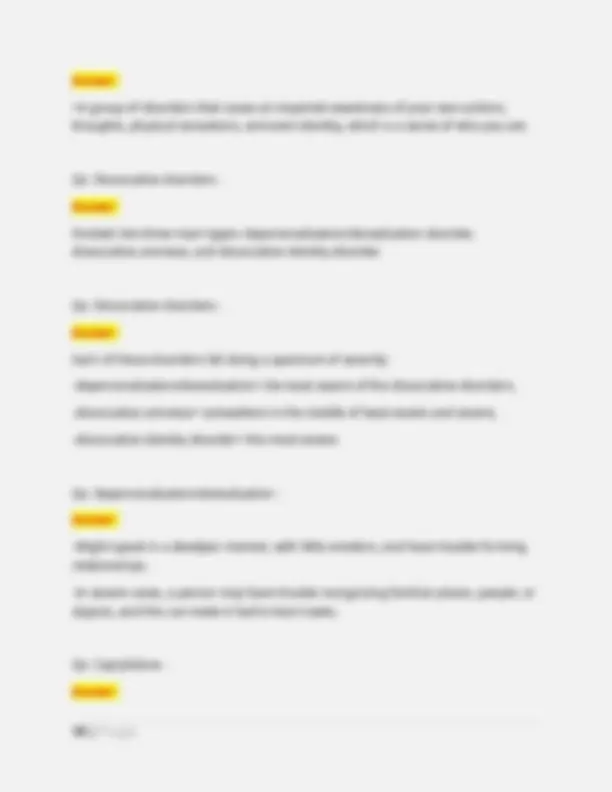
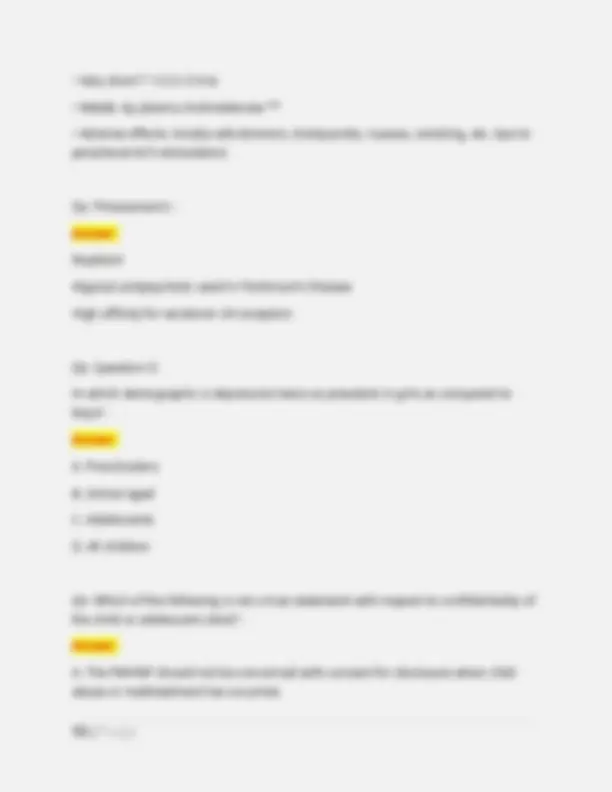
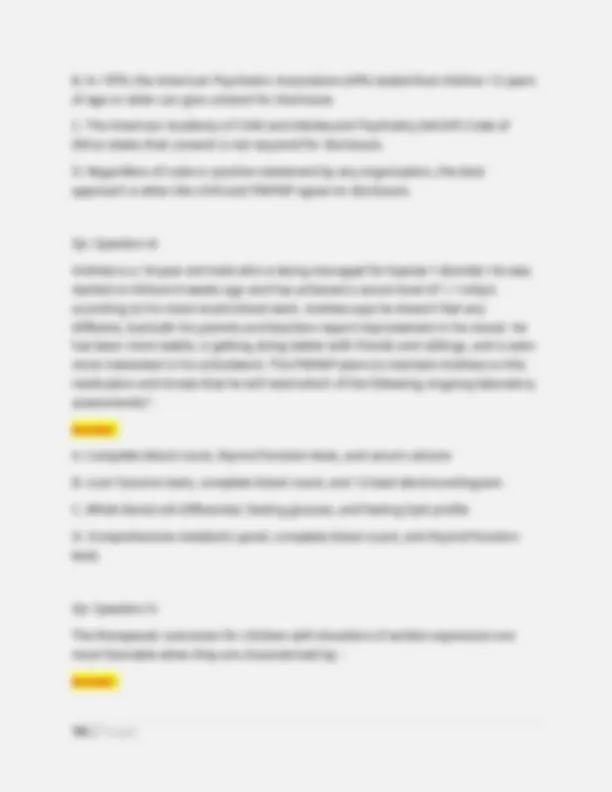
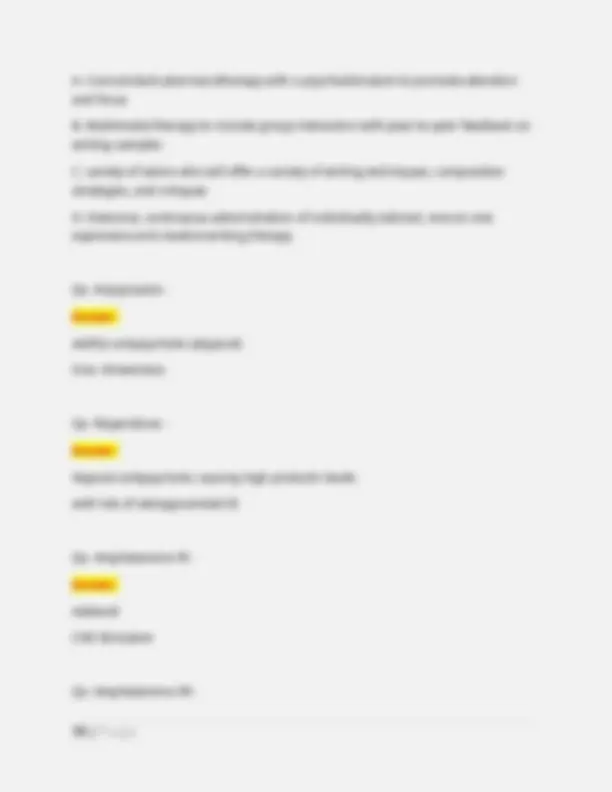
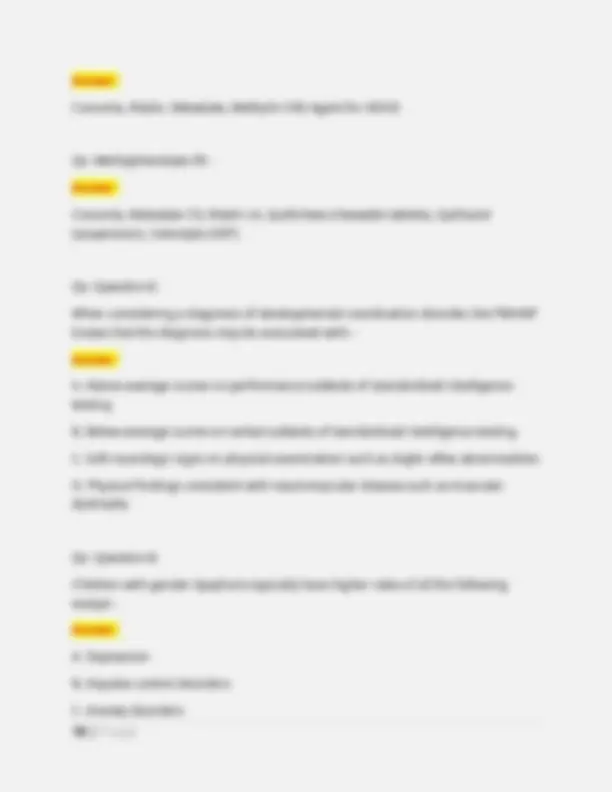
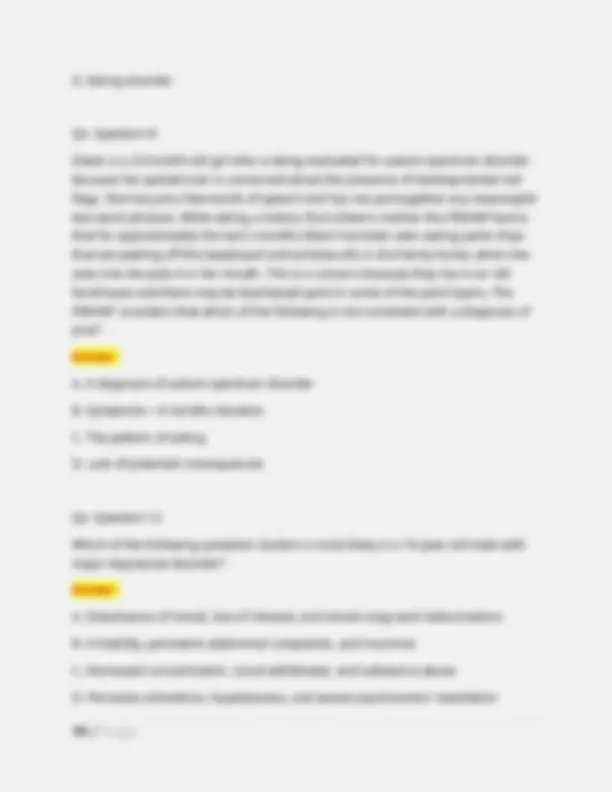
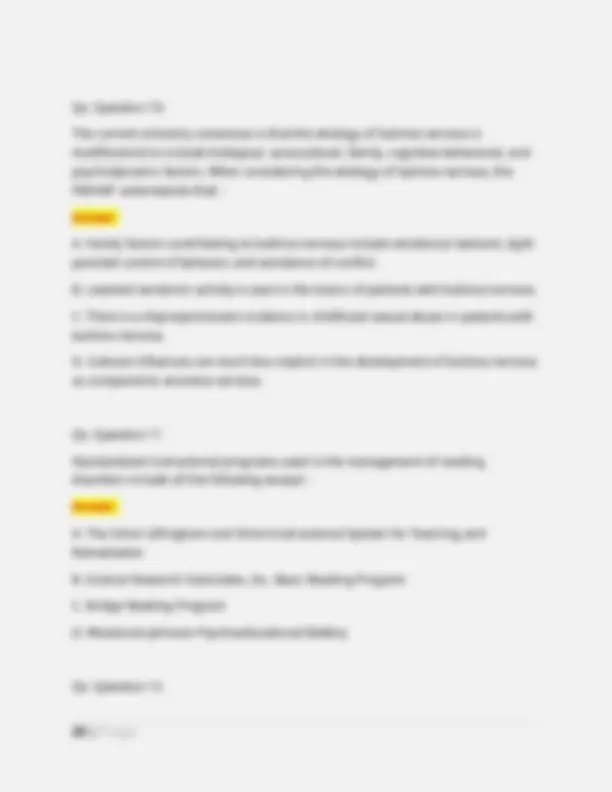
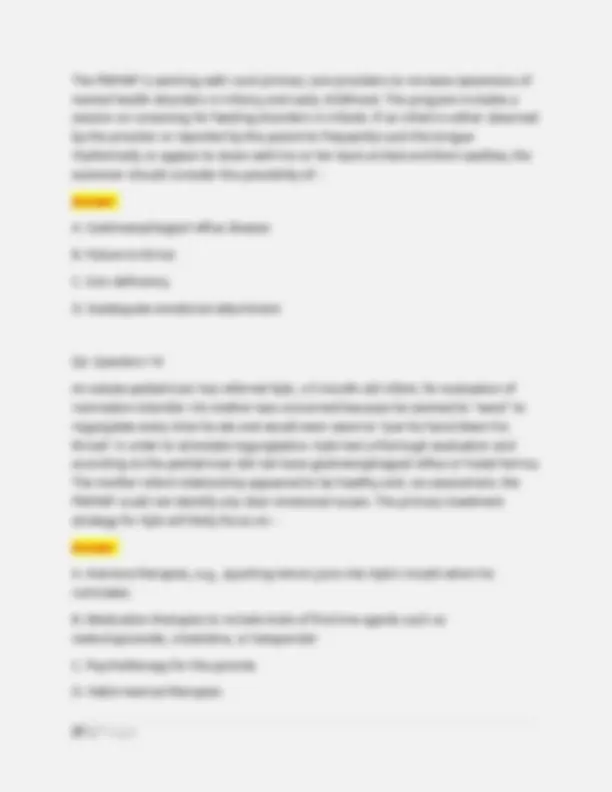
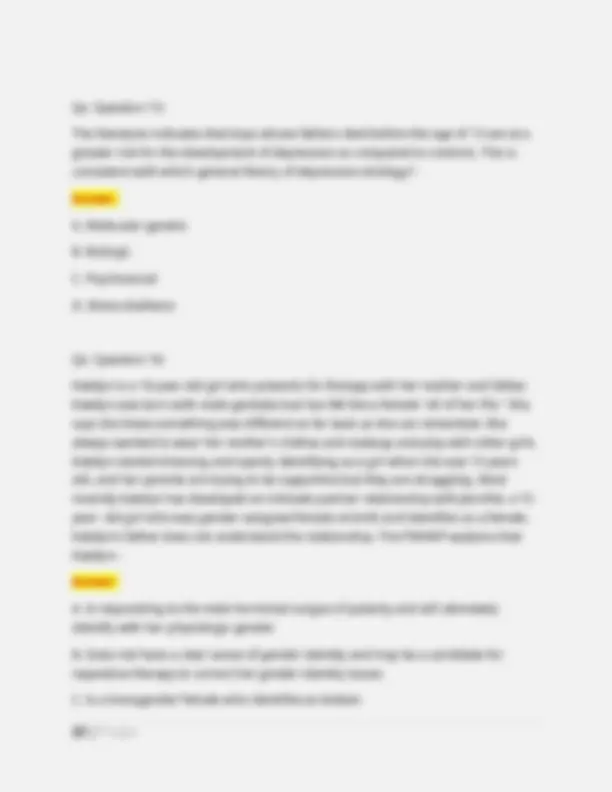
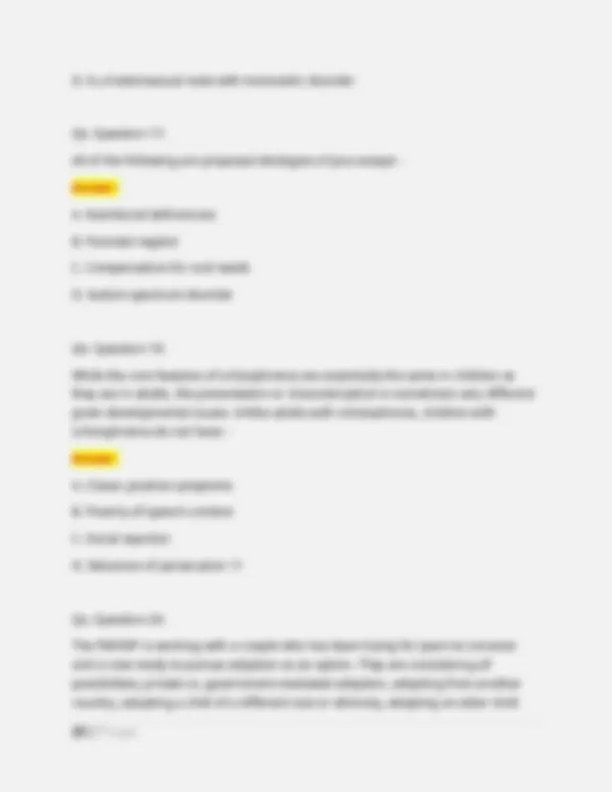
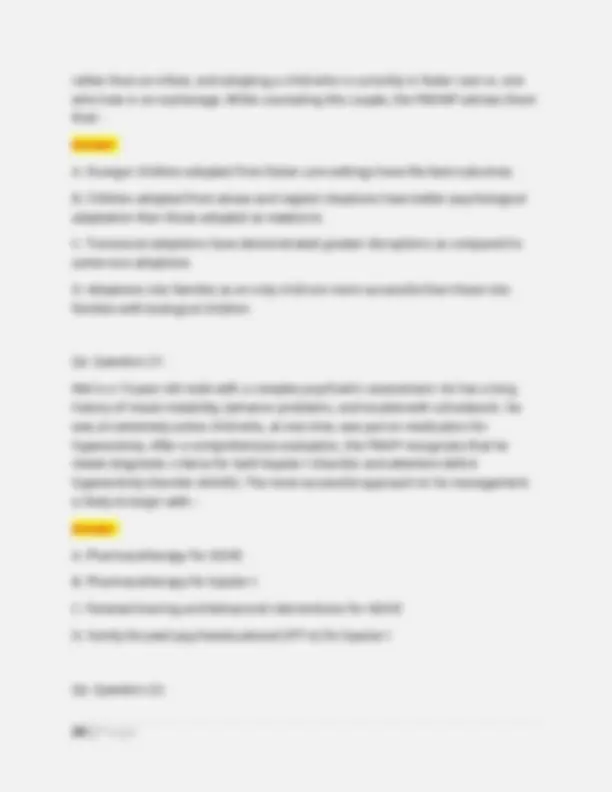
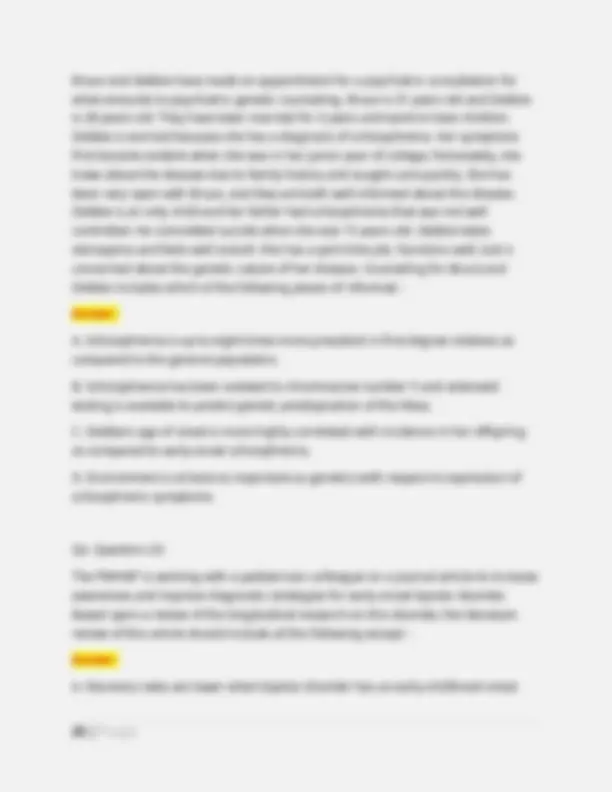
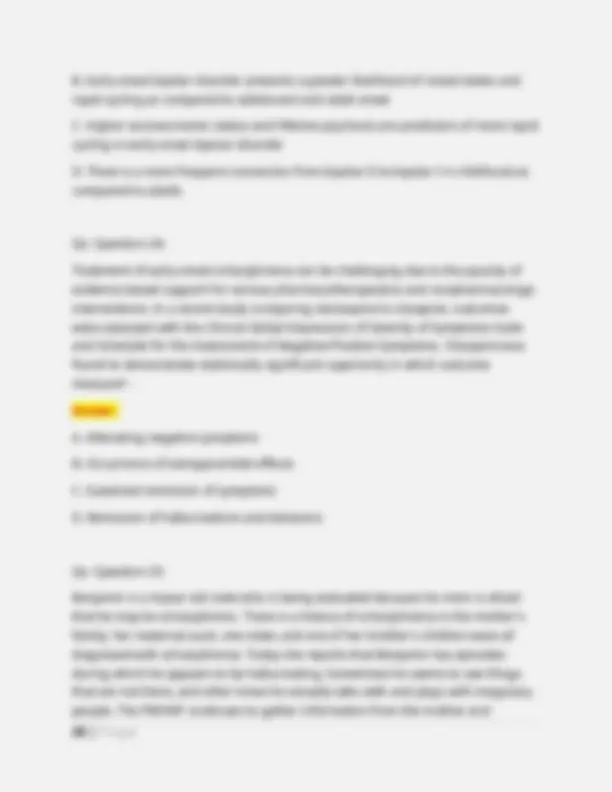
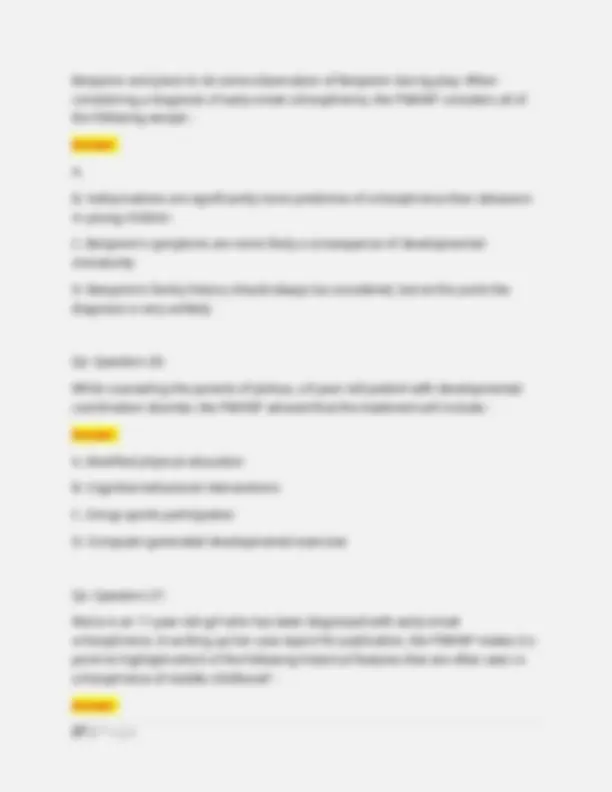
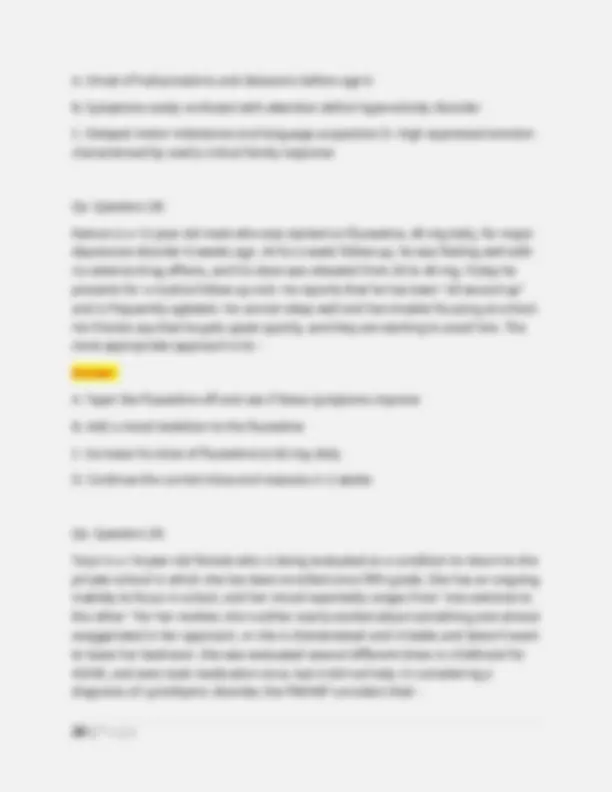
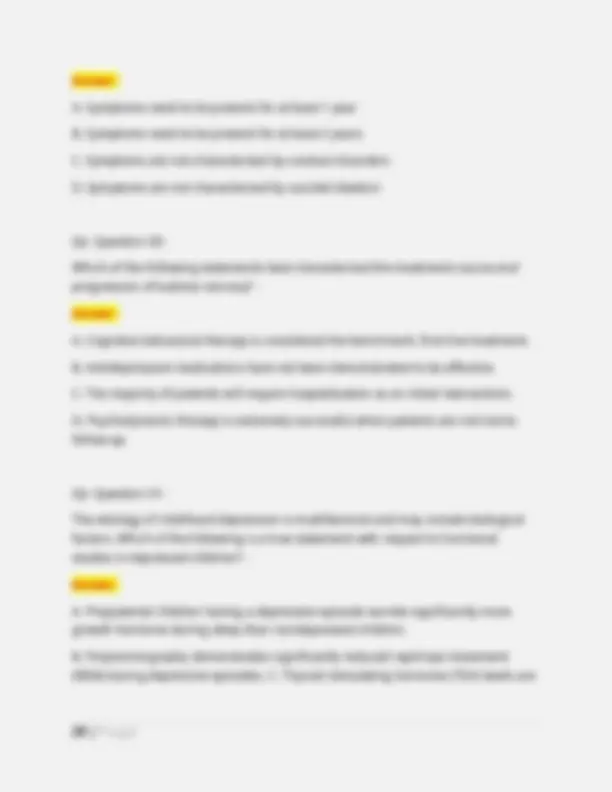
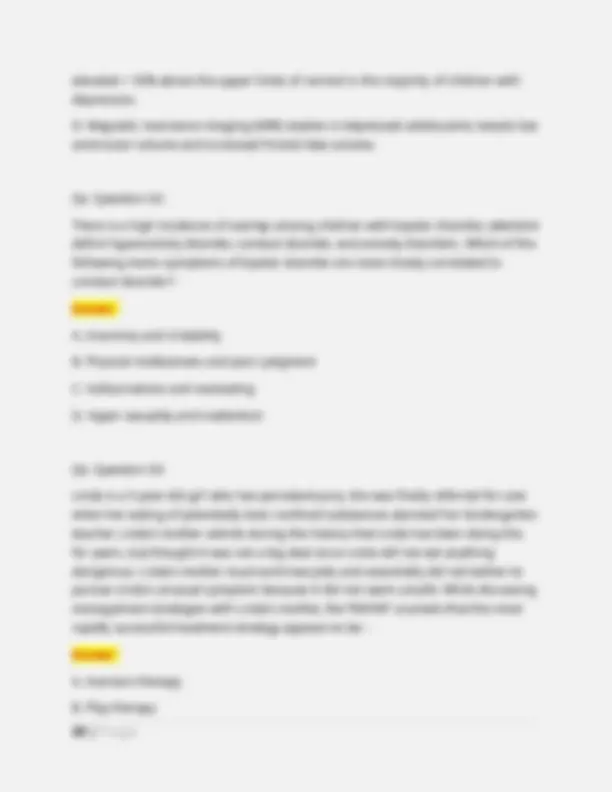
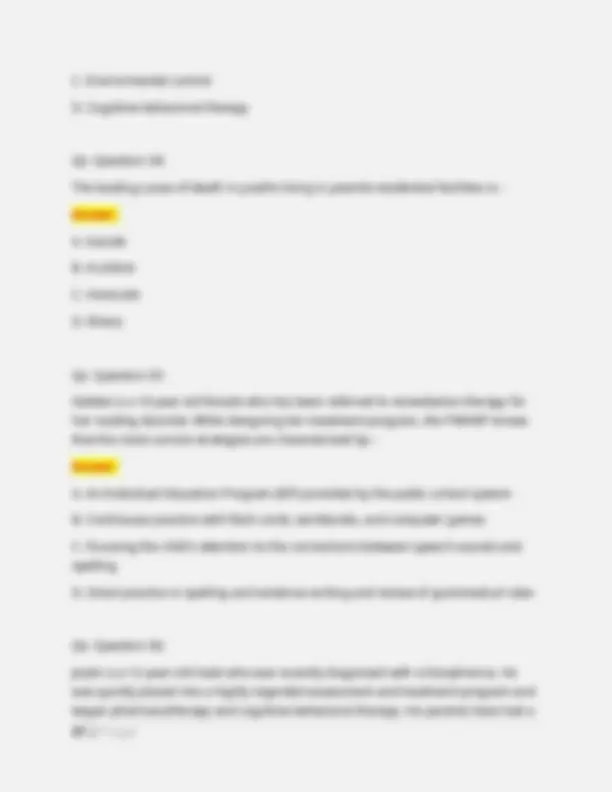
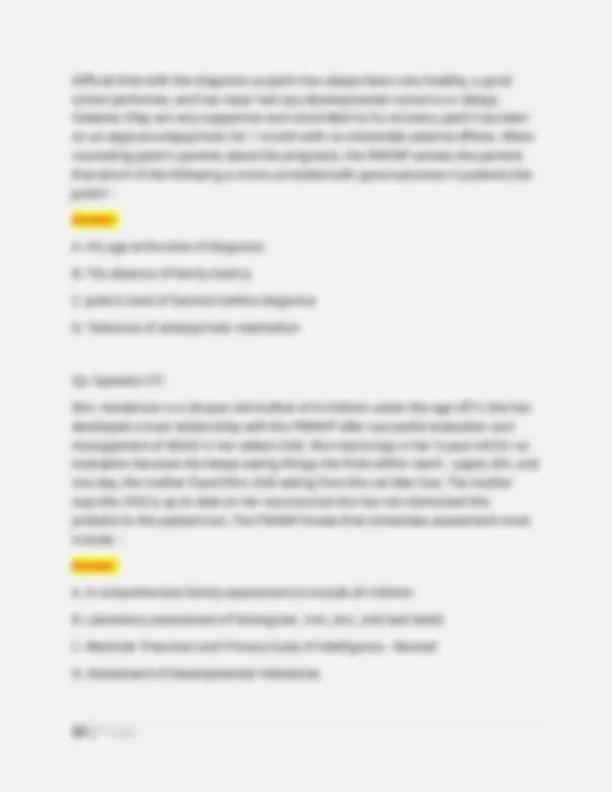
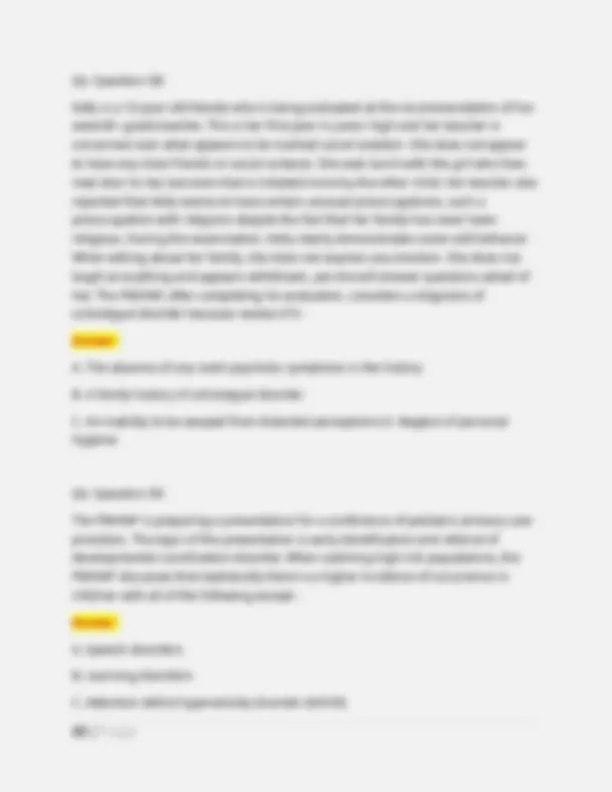
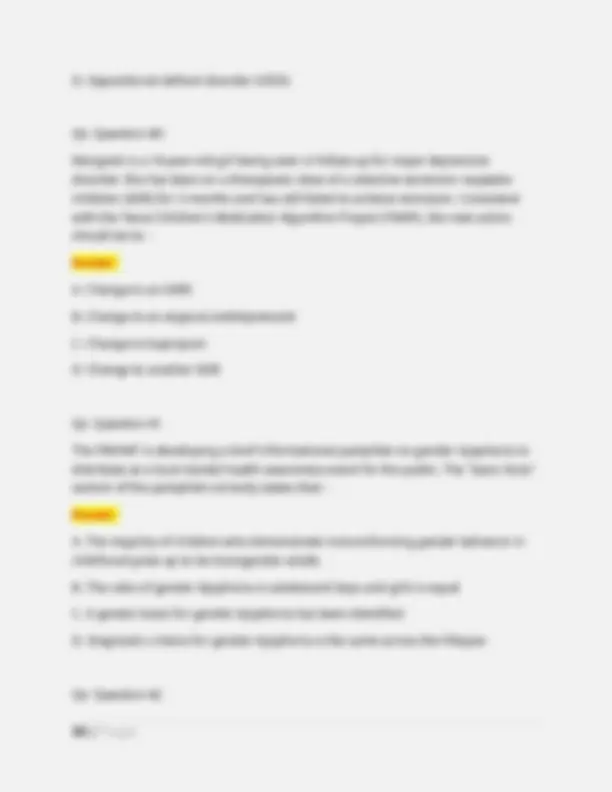
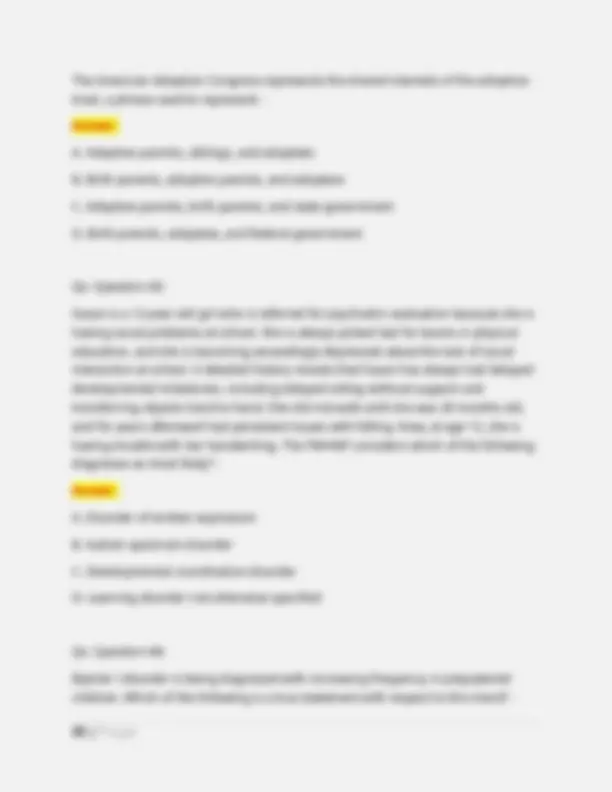
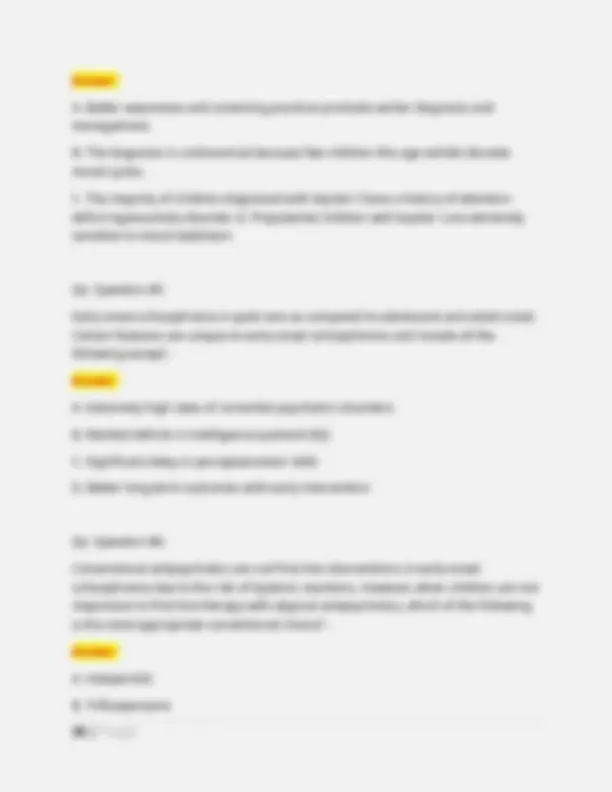
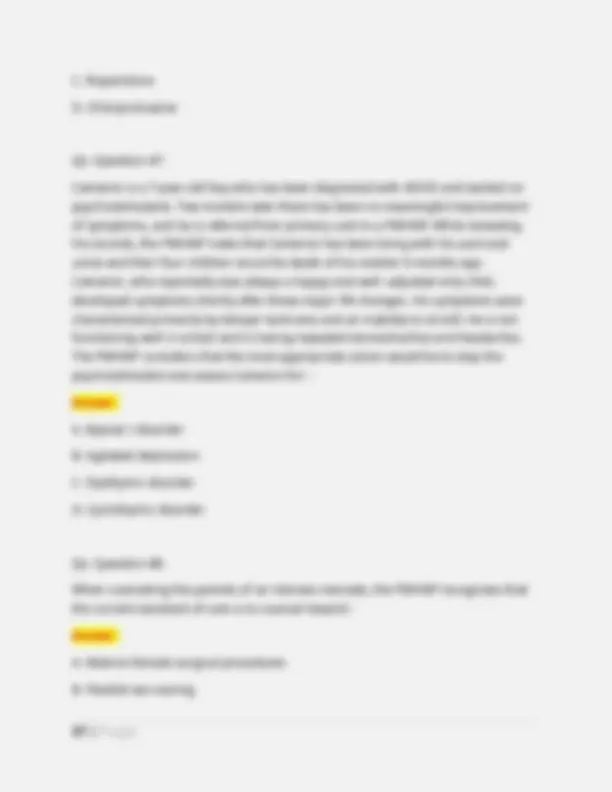
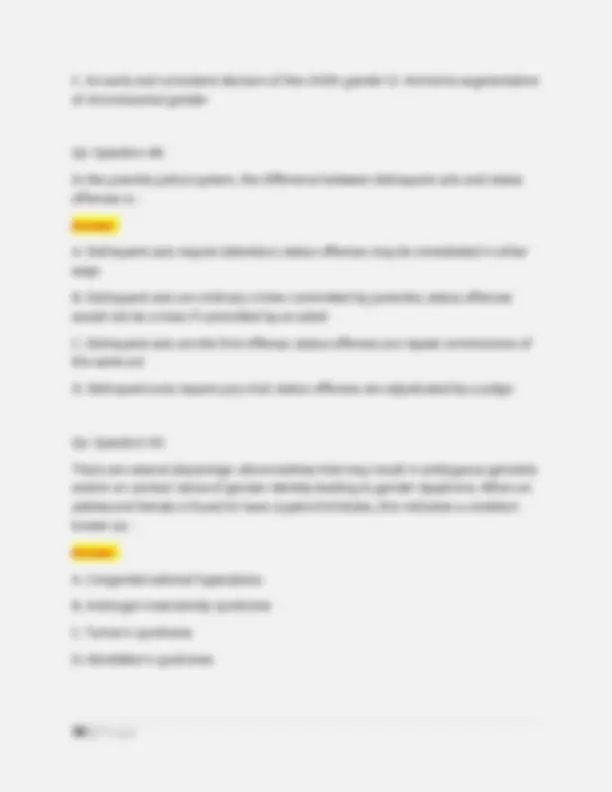
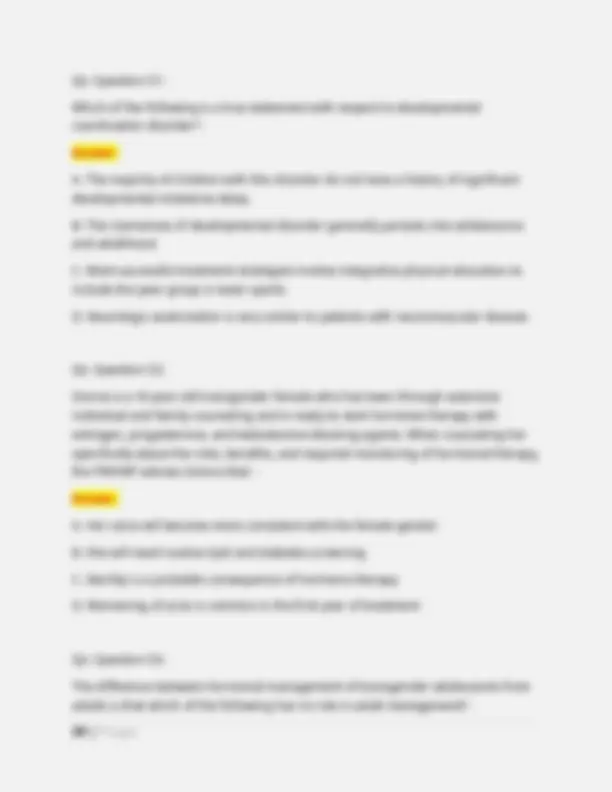
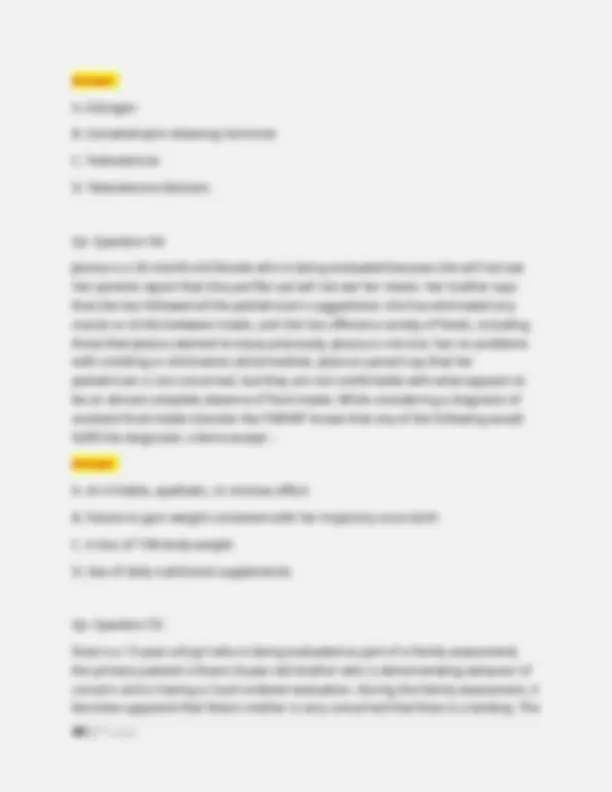
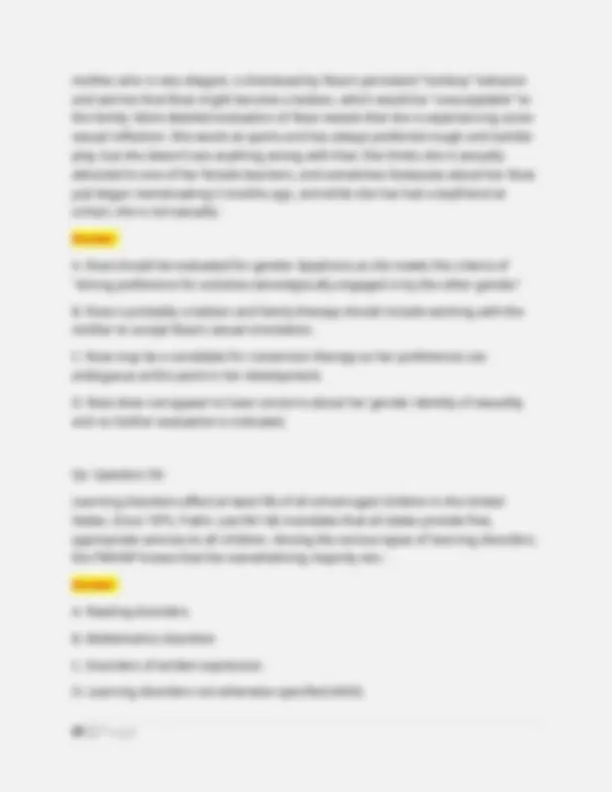
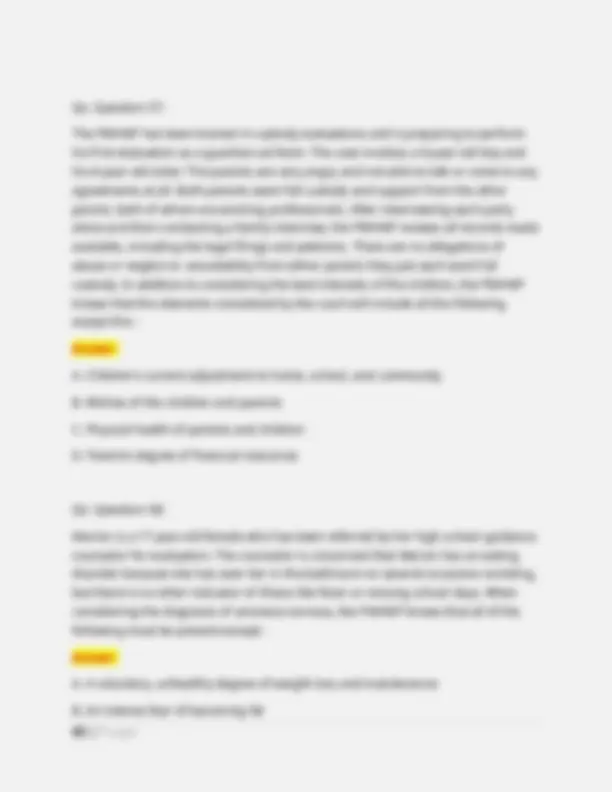
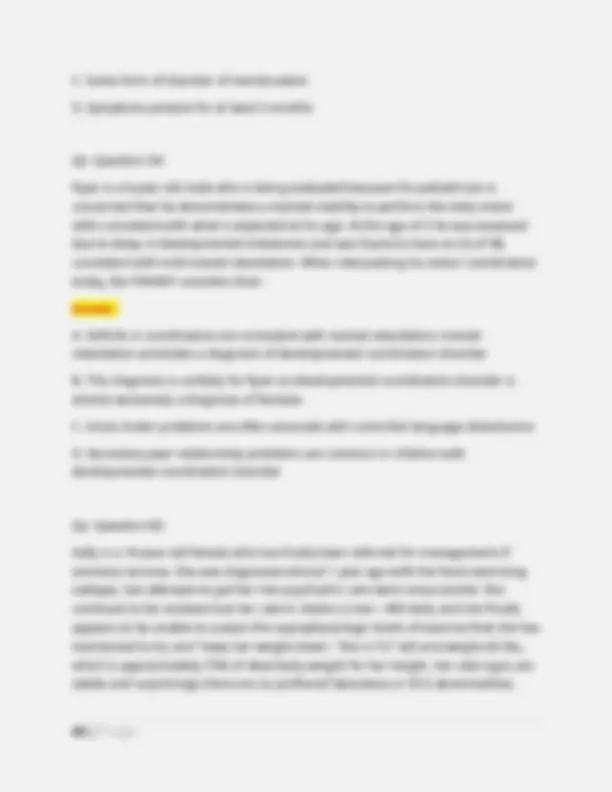
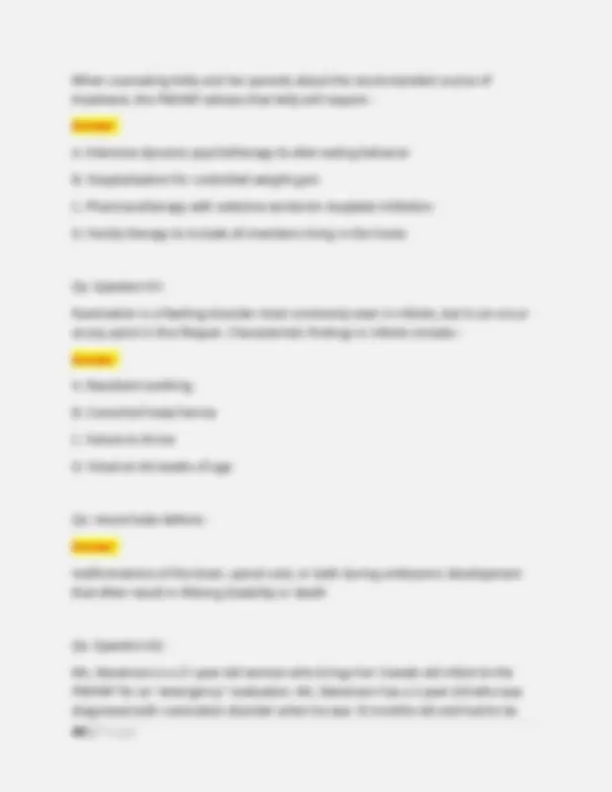
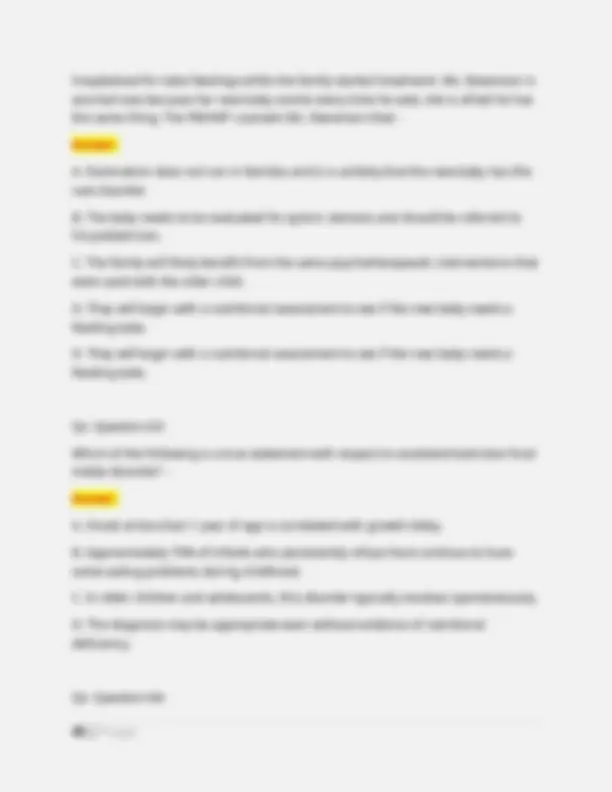
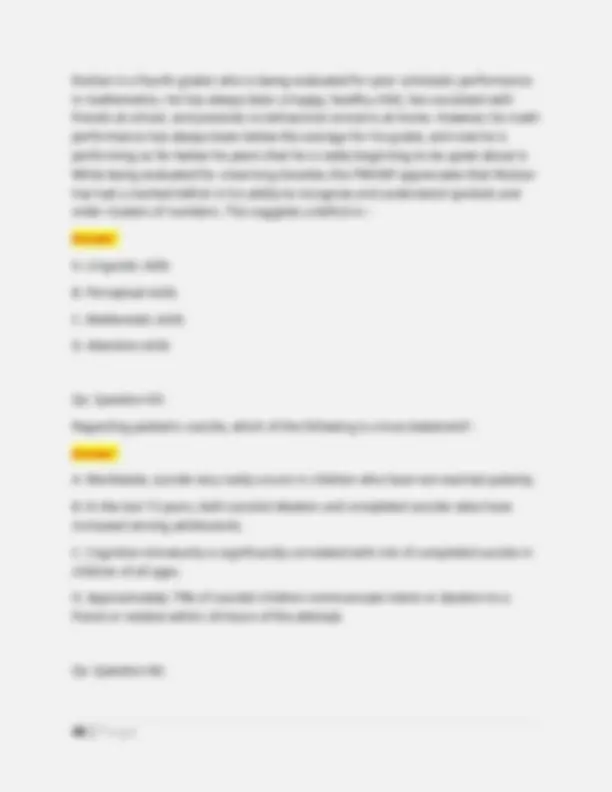
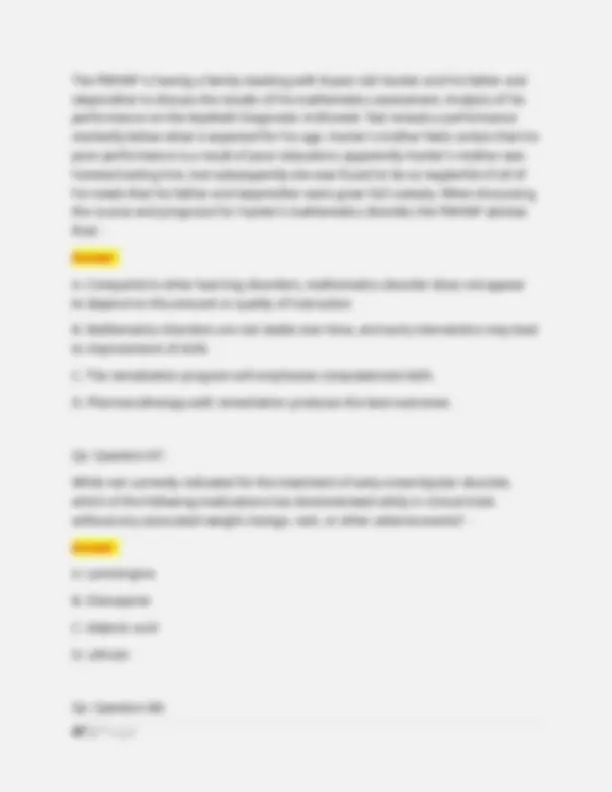
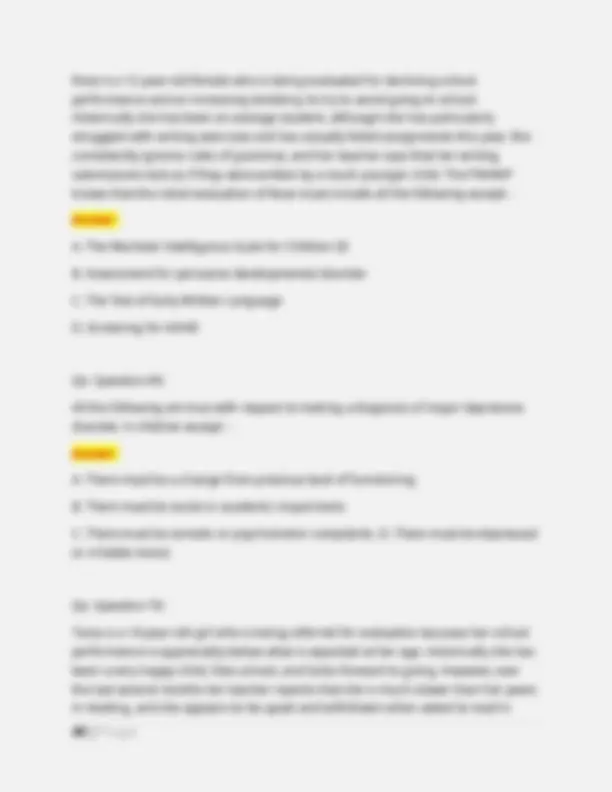
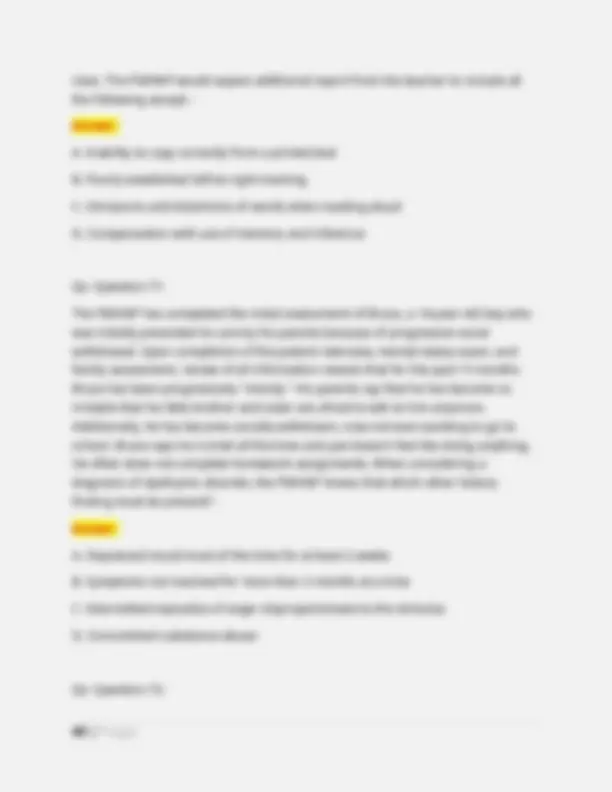
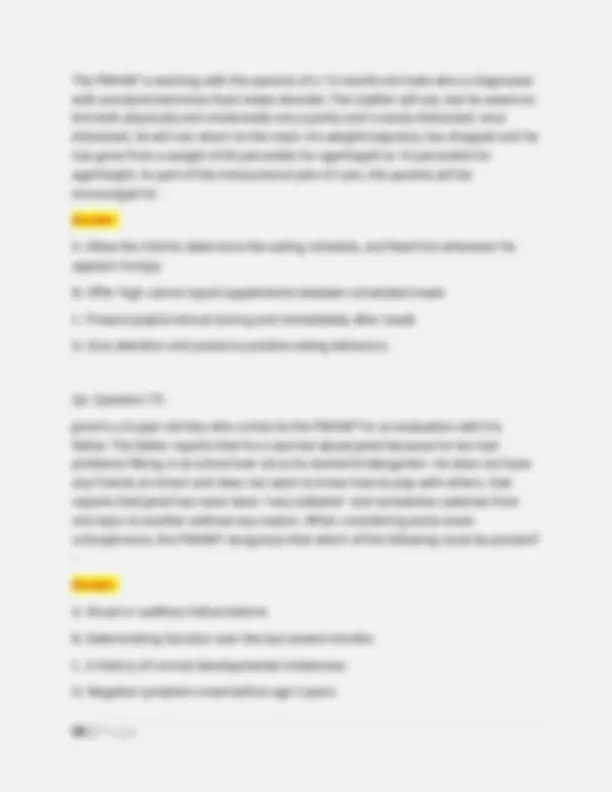
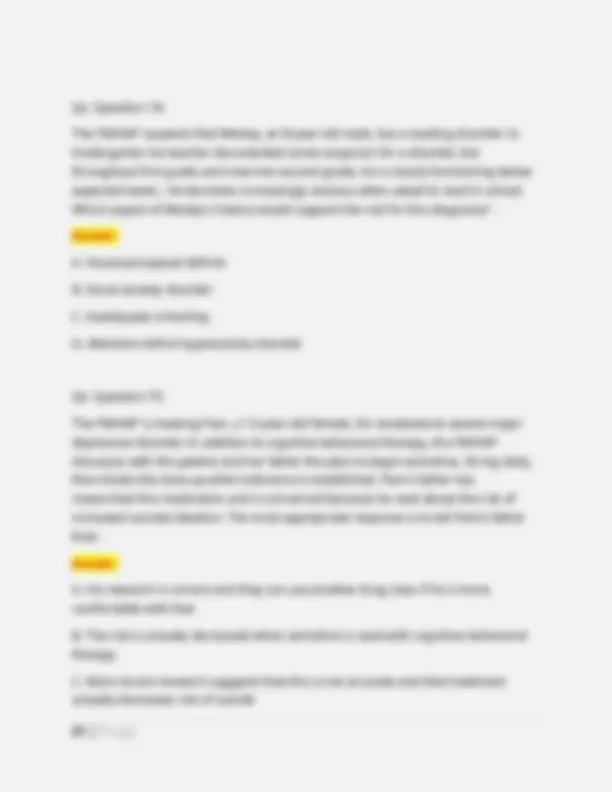
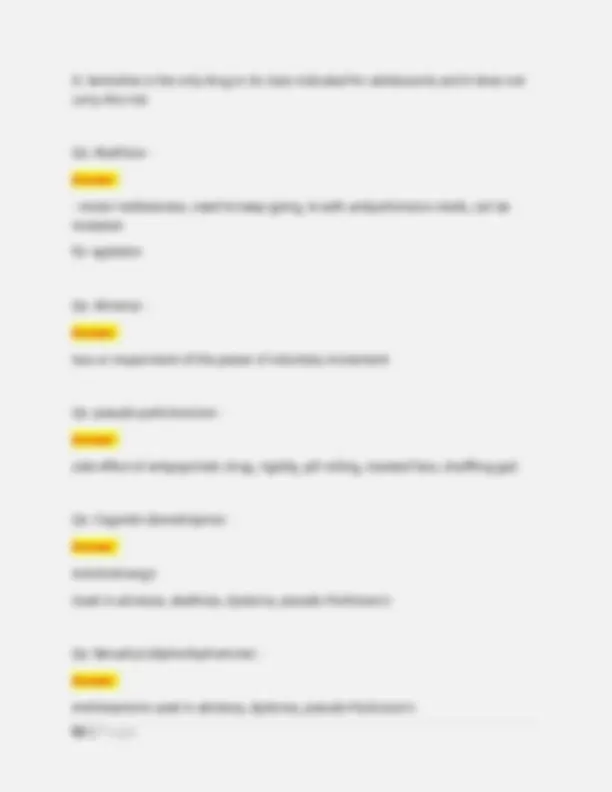
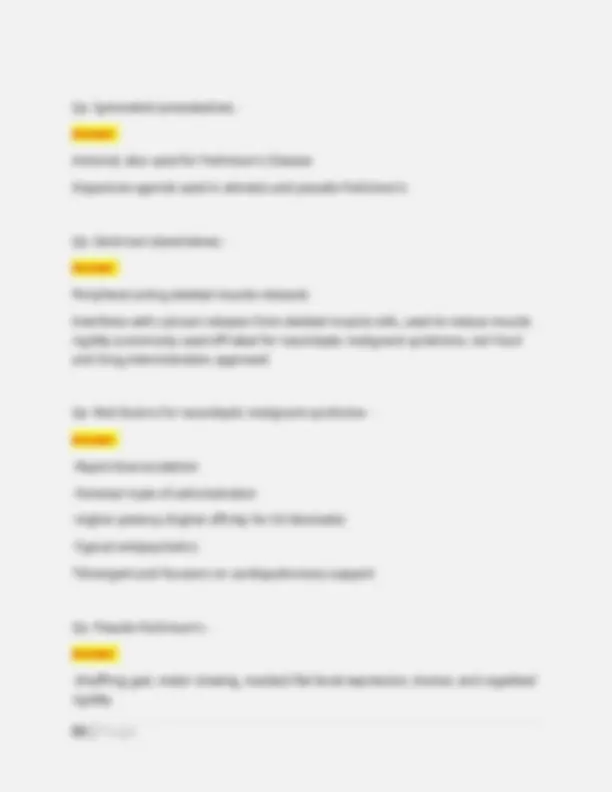



Study with the several resources on Docsity

Earn points by helping other students or get them with a premium plan


Prepare for your exams
Study with the several resources on Docsity

Earn points to download
Earn points by helping other students or get them with a premium plan
Community
Ask the community for help and clear up your study doubts
Discover the best universities in your country according to Docsity users
Free resources
Download our free guides on studying techniques, anxiety management strategies, and thesis advice from Docsity tutors
A series of questions and answers related to psychopharmacology, focusing on medications used to treat depression, anxiety, and other mental health disorders. It covers various antidepressants such as ssris, tricyclic antidepressants, and atypical antipsychotics, detailing their mechanisms of action, brand names, and potential side effects. The content is structured as a study guide, providing concise information useful for exam preparation or quick reference. It also includes information on medications used to treat alzheimer's disease and adhd. Useful for students and professionals in the fields of medicine, pharmacy, and nursing. Useful for students and professionals in the fields of medicine, pharmacy, and nursing. Useful for students and professionals in the fields of medicine, pharmacy, and nursing.
Typology: Exams
1 / 54

This page cannot be seen from the preview
Don't miss anything!















































Question 18: Christine is a 9-year-old female who presents for care after having been placed in the local foster care system. She has been in and out of foster care for the last 4 years after her parents were killed in an automobile accident. Christine has been placed in a variety of homes and residential care facilities. The PMHNP recognizes that Christine is at high risk for: - Answer: A. Dissociative disorders B. Post-traumatic stress disorder C. Impulse-control disorder D. Attachment disorder Qs: Question 7: Caylee is a 5-year-old girl who is referred for evaluation by child protective services. She was recently removed from her biological family and placed in foster care, as her home environment was reportedly unsafe due to conditions of extreme neglect. Her foster mother reports that Caylee is very quiet and withdrawn and always appears sad and disinterested in her surroundings; however, she becomes very irritable when anything unexpected or unplanned occurs. The foster mother became very concerned when it appeared that Caylee was hallucinating. The PMHNP considers that: - Answer: A. Caylee is at high risk for suicide and precautions should be taken
B. The hallucinations are consistent with brief psychotic disorder or schizophrenia C. The history and reported symptoms are typical of depressive disorder in young children D. This is a common situation when prepubertal children are removed from the biological parents regardless of how dysfunctional they are Qs: Question 2: Debi is a 15-year-old girl who is currently being treated for depression. Her parents have been very proactive and involved in her care, and Debi has achieved remission 2 months after beginning treatment with a combination of pharmacotherapy and cognitive behavioral therapy. While counseling Debi's parents about important issues in management, the PMHNP advises that: - Answer: A. There is a > 50% likelihood that Debi's younger sibling will develop depressive symptoms B. The mean length of major depressive episode in adolescents is 4 months C. 20 to 40% of adolescents who have major depressive disorder will develop bipolar I within 5 years D. Adolescent-onset depression typically need long-term pharmacologic management to prevent relapses Qs: Agomelatine - Answer: Brand: Valdoxan -Melatonin multimodal (Mel-MM) -Agonist at melatonergic 1 and melatonergic 2 receptors -Antagonist at 5HT2C receptors
Antidepressant, SSRI: 20-40 mg qd. Qs: Clomipramine (Anafranil) - Answer: -Serotonin reuptake inhibitor (S-RI) -Tricyclic antidepressant (TCA) -Parent drug is a potent serotonin reuptake inhibitor Active metabolite is a potent norepinephrine/noradrenaline reuptake inhibitor -Increases serotonergic neurotransmission by blocking the serotonin reuptake pump (transporter), -Desensitization of serotonin receptors, especially serotonin 1A receptors -Increases noradrenergic neurotransmission by blocking the norepinephrine reuptake pump (transporter), -Desensitization of beta adrenergic receptors -Dopamine is inactivated by norepinephrine reuptake in the frontal cortex -Lacks dopamine transporters -Increases dopamine neurotransmission in this part of the brain **FDA Approved for Pediatrics in tx Obsessive-compulsive disorder (OCD) (ages 10 and older) *Off-Label for Pediatric Use: Depression, Severe and treatment-resistant, depression, Cataplexy syndrome, Anxiety, Insomnia, Neuropathic pain/chronic pain -Full therapeutic benefits may take 2-8 weeks -Dosing: in Peds/Adolescents/Adults: 100-250mg/day Qs: Cyamemazine (Tercian) -
Answer: Treatment for depression. -Known as cyamepromazine -Typical antipsychotic drug of the phenothiazine class. -Treatment for schizophrenia and psychosis-associated anxiety -Behaves like an atypical antipsychotic, due to its potent anxiolytic effects (5-HT2C) and lack of extrapyramidal side effects (5-HT2A). -Conventional antipsychotic (neuroleptic, phenothiazine, dopamine 2 antagonist, serotonin dopamine antagonist) -Commonly Prescribed for (not FDA approved): -Schizophrenia -Anxiety associated with psychosis (short-term) -Anxiety associated with nonpsychotic disorders, including mood disorders and personality disorders (short-term) -Severe depression -Bipolar disorder -Other psychotic disorders -Acute agitation/aggression (injection) -Benzodiazepine withdrawal Qs: Desiprimine (Norpramine) - Answer:
Qs: Risperidone (Risperdal) - Answer: Atypical Antipsychotic (most "typical" of atypicals) Side effects: EPS (dose-dependent), TD, significant increases in PRL (check PRL levels) --> most dopaminergic of Atypicals IM formulation is available Qs: Amphetamines - Answer: drugs that stimulate neural activity, causing speeded-up body functions and associated energy and mood changes Qs: Dextroamphetamine - Answer: CNS stimulant Mech: Inc catecholamines at the synaptic cleft, especially NE and dopamine. Use: ADHD, narcolepsy, apetite control Qs: Atomoxetine (Strattera) - Answer:
Risk of suicidal ideation; monitor for suicidal thinking or behavior, worsening, or unusual behavior
Glaucoma, pheochromocytoma, MAO I use within past 14 days
Rare, but severe hepatotoxicity (most within 120 days of start of treatment) SE Headache, insomnia, somnolence, dry mouth, nausea, abdominal pain, decrease in appetite, nausea, etc. Priapism NOTE
- do not open capsule * - irritant CYPD 2D6 substrate watch out for *LIVER PROBLEMS * Qs: Clonidine Hydrochloride - Answer: Catapres, Catapres TTS, Kapvay (Antihypertensive) Qs: Dexmethylphenidate Hydrochloride - Answer: Focalin; Focalin XR Tablet, capsule CNS Stimulant ADHD
Answer: =A group of disorders that cause an impaired awareness of your own actions, thoughts, physical sensations, and even identity, which is a sense of who you are. Qs: Dissociative disorders - Answer: Divided into three main types: depersonalization/derealization disorder, dissociative amnesia, and dissociative identity disorder. Qs: Dissociative disorders - Answer: Each of these disorders fall along a spectrum of severity: -depersonalization/derealization= the least severe of the dissociative disorders, -dissociative amnesia= somewhere in the middle of least severe and severe, -dissociative identity disorder= the most severe. Qs: Depersonalization/derealization - Answer: -Might speak in a deadpan manner, with little emotion, and have trouble forming relationships. -In severe cases, a person may have trouble recognizing familiar places, people, or objects, and this can make it had to learn tasks. Qs: Caprylidene - Answer:
Medical food approved by FDA for treatment of (AD) Axona Qs: Aducanumab - Answer:
B. In 1979, the American Psychiatric Association (APA) stated that children 12 years of age or older can give consent for disclosure. C. The American Academy of Child and Adolescent Psychiatry (AACAP) Code of Ethics states that consent is not required for disclosure. D. Regardless of code or position statement by any organization, the best approach is when the child and PMHNP agree on disclosure. Qs: Question 4: Andrew is a 14-year-old male who is being managed for bipolar I disorder. He was started on lithium 6 weeks ago and has achieved a serum level of 1.1 mEq/L according to his most recent blood work. Andrew says he doesn't feel any different, but both his parents and teachers report improvement in his mood. He has been more stable, is getting along better with friends and siblings, and is even more interested in his schoolwork. The PMHNP plans to maintain Andrew on this medication and knows that he will need which of the following ongoing laboratory assessments? - Answer: A. Complete blood count, thyroid function tests, and serum calcium B. Liver function tests, complete blood count, and 12-lead electrocardiogram C. White blood cell differential, fasting glucose, and fasting lipid profile D. Comprehensive metabolic panel, complete blood count, and thyroid function tests Qs: Question 5: The therapeutic outcomes for children with disorders of written expression are most favorable when they are characterized by: - Answer:
Answer: Adderall (XR) CNS Stimulant Qs: Dextroamphetamine - Answer: CNS stimulant Mech: Inc catecholamines at the synaptic cleft, especially NE and dopamine. Use: ADHD, narcolepsy, apetite control Qs: Atomoxetine (Strattera) - Answer:
Risk of suicidal ideation; monitor for suicidal thinking or behavior, worsening, or unusual behavior
Glaucoma, pheochromocytoma, MAO I use within past 14 days
Rare, but severe hepatotoxicity (most within 120 days of start of treatment) SE Headache, insomnia, somnolence, dry mouth, nausea, abdominal pain, decrease in appetite, nausea, etc. Priapism NOTE
- do not open capsule * - irritant CYPD 2D6 substrate
watch out for *LIVER PROBLEMS * Qs: Clonidine - Answer: alpha 2 agonist -treatment for hypertension and opioid withdrawal -side effects of bradycardia and hypotension Qs: Dexmethylphenidate - Answer: ADHD stimulant Qs: Guanfacine Hydrochloride - Answer: *Antihypertensive/Antipsychotic *Tenex, Intuniv Qs: Lisdexamfetamine - Answer: Vyvanse ADHD C-II Qs: Methylphenidate -
D. Eating disorder Qs: Question 9: Eileen is a 23-month-old girl who is being evaluated for autism spectrum disorder because her pediatrician is concerned about the presence of developmental red flags. She has just a few words of speech and has not put together any meaningful two-word phrases. While taking a history from Eileen's mother the PMHNP learns that for approximately the last 2 months Eileen has been seen eating paint chips that are peeling off the baseboard and window sills in the family home; when she sees one she puts it in her mouth. This is a concern because they live in an old farmhouse and there may be lead-based paint in some of the paint layers. The PMHNP considers that which of the following is not consistent with a diagnosis of pica? - Answer: A. A diagnosis of autism spectrum disorder B. Symptoms < 6 months duration C. The pattern of eating D. Lack of potential consequences Qs: Question 12 Which of the following symptom clusters is most likely in a 16-year-old male with major depressive disorder? - Answer: A. Disturbance of mood, loss of interest, and mood-congruent hallucinations B. Irritability, persistent abdominal complaints, and insomnia C. Decreased concentration, social withdrawal, and substance abuse D. Pervasive anhedonia, hopelessness, and severe psychomotor retardation
Qs: Question 10: The current scholarly consensus is that the etiology of bulimia nervosa is multifactorial to include biological, sociocultural, family, cognitive-behavioral, and psychodynamic factors. When considering the etiology of bulimia nervosa, the PMHNP understands that: - Answer: A. Family factors contributing to bulimia nervosa include emotional restraint, tight parental control of behavior, and avoidance of conflict. B. Lowered serotonin activity is seen in the brains of patients with bulimia nervosa. C. There is a disproportionate incidence in childhood sexual abuse in patients with bulimia nervosa. D. Cultural influences are much less implicit in the development of bulimia nervosa as compared to anorexia nervosa. Qs: Question 11 Standardized instructional programs used in the management of reading disorders include all the following except: - Answer: A. The Orton Gillingham and Direct Instructional System for Teaching and Remediation B. Science Research Associates, Inc. Basic Reading Program C. Bridge Reading Program D. Woodcock-Johnson Psychoeducational Battery Qs: Question 13